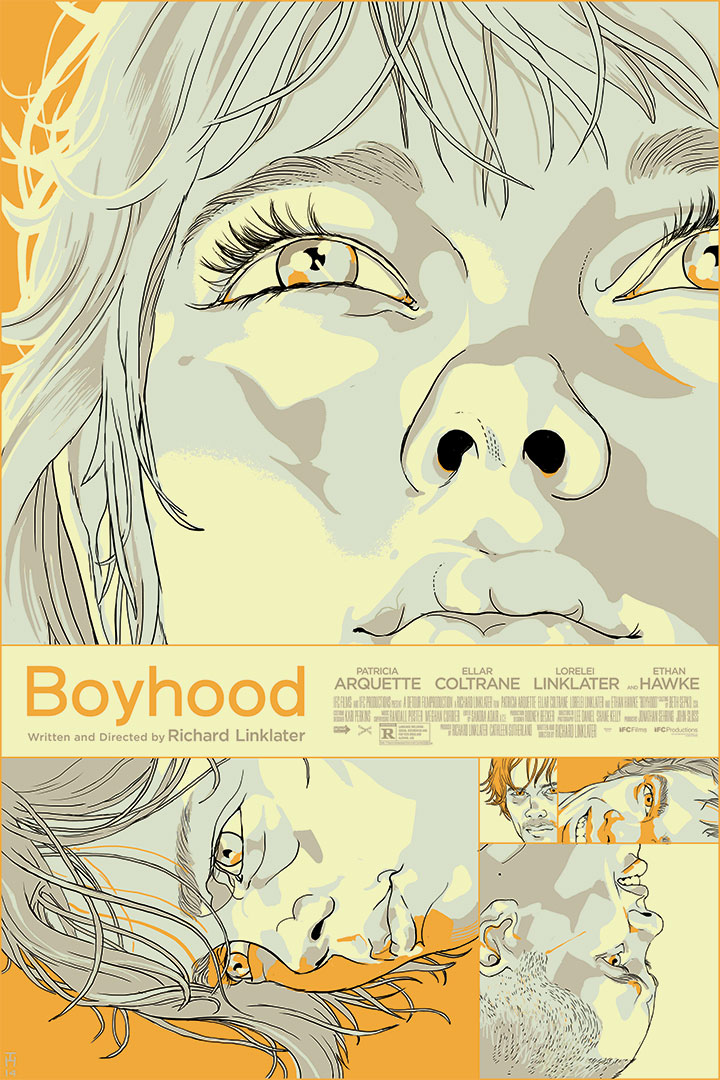I absolutely loved Richard Linklater’s film Boyhood, which is nominated for a few Oscars this year, including Best Picture. (Boyhood is too good to win best picture; I’m fine with that prize going to Iñárritu’s faux-art film Birdman). A rich and sentimental evocation of “reality,” Boyhood synthesizes the best elements of Linklater’s previous films, and like many of those films—Slacker, the Before trilogy, Waking Life, Dazed and Confused—Boyhood isn’t really about anything. Of course it’s also kinda sorta about everything: family, love, growth, education, life. Etc.
The central formal device of Boyhood—namely, that Linklater shot the film over twelve years using the same actors—has been remarked upon at great length by others, so I won’t touch on it, other than to say that I found watching Ellar Coltrane’s Mason grow up profoundly moving. The aesthetic experience of Boyhood is its greatest pleasure, much like its sister film The Tree of Life. And although Boyhood’s aesthetic power relies in large part on our witnessing its characters grow and age, its emotional tenor, its vibe, inheres from scene to scene.

There are many wonderful moments in the film, some more memorable than others, but a favorite of mine takes place at an overnight “camping trip” in a house that’s still under construction. Mason is maybe, what, thirteen here?—I’m not quite sure, but he tells his mother the truth about where he’s going, if not entirely the truth about what he’ll be doing there…which is, what? Not much really—the younger kids hang out with the older kids, drink a beer or two, lie about sex—stuff kids do. The scene captures the same not-quite-boring hangout vibe that permeates Dazed and Confused and Waking Life—a kind of familiar realness.
Linklater is a master at evoking a sense of place. And this place, this house—it’s simultaneously boring, calming, and horrifying. On one hand, we’ve been there before—the abandoned house, the empty parking lot, the little switch of trees that aren’t quite woods, not really—the free space where we can play at being adults. On the other hand, Boyhood has allowed us—or maybe I should not extend my pronoun to the plural? No?—Okay: Boyhood has allowed me, this viewer, a kind of paternalistic view of Mason (“my-son”) who is, after all, growing up before our very eyes (sorry for slipping back into the first-person plural there). And here Linklater has young Mason—whom we trust to do the right thing and all but still—here Linklater has staged Mason & co. in an abandoned house full of scrap wood and power tools and circular saw blades which the young men are of course throwing into the sheet rock with gleeful abandon.
I flinched as the blades flew forcefully past Mason and his friend; in any other film they would have to cut into flesh and bone, be tools for forces tragic or comic. Plot devices. But in Boyhood they are the toys of boys playing at growing up. Nothing happens. No grievous injury or terrible death—the sort of thing that usually licenses, I don’t know, the central character’s maturation. Not even a comic wound. Nothing. The blade-throwing is just normal bored stupid teenage amusement. It’s the sort of thing that Mason’s mom—and a paternalistic viewer like me—might find horrifying—You could get very badly hurt, Mason!—but he doesn’t. He’s fine. He’s alive.
For me, this particular scene—not the strongest or the strangest or the most memorable or moving—is nevertheless a key moment in Boyhood, not just because it disrupts audience expectations (the film is full of such gentle disruptions), but because it engenders and then discharges my own parental anxieties. That’s a form of catharsis, I guess, but not a catharsis of tragedy. It’s catharsis for reality.


I have seen the Boyhood as well and it’s so interesting to see (read) it again with your eyes. Not a totally, but quite different movie. But I think, this is the thing with a good movie: It gives people a kaleidoscope of perceptions.
LikeLiked by 1 person
Loved your thoughts on this one, Edwin.
I’m in my early twenties and without kids. That being said, I didn’t have the same paternalistic thoughts during this scene but I think I understand where you’re coming from. I instead fixated on the question of whether Mason was lying about getting laid. I love how, because of the films designs — its inclusions and exclusions –, I was left to only surmise whether or not he really did get laid. I doubt he did and it sounds like from your words above you did too.
I also really appreciate that you pointed out Boyhood’s kinship w/ The Tree of Life. The Tree of Life also captures the experience of life in a thoroughly captivating way.
LikeLike
I can’t wait until I get a chance to see this. It won’t make it too my small appalachian ville–not enough cute cartoon people or boneshaking explosions, I’m afraid. Nice post.
LikeLike
Great read on a great film–thanks for posting this!
LikeLike
You use “vibe” quite a bit in your film reviewing. I’m curious your thoughts on the term — how you would formalize it, whether vibe-centric filmmaking has become more prevalent and popular.
LikeLike